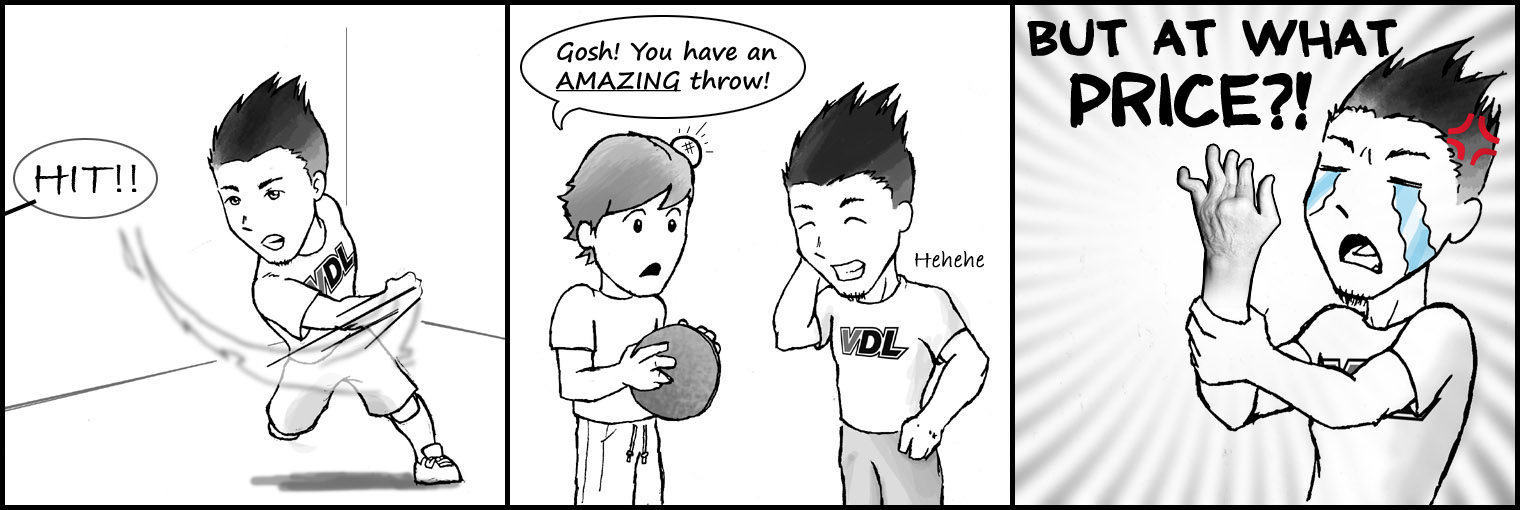
Warning: Graphic images ahead
In a previous post, the topic of finger sprains was discussed. As it is quite a common injury, many VDL players tape their fingers for protection each time they play dodgeball. Unfortunately, sometimes athletic tape can only do so much and our fingers end up being injured anyway. Usually finger sprains recover without any medical treatment aside from rest and time; however, if a severely and/or repeatedly sprained finger is left alone without medical treatment, it can lead to other consequences such as a permanently crooked finger!
Finger Deformities
Look down at your hands: you might notice that not all your fingers are straight. Is it a finger you’ve injured before? As long as it doesn’t impede your daily functions or cause discomfort, a crooked finger is not something to worry about….for now.
Common sports-related finger deformities
Mallet Finger
Mallet finger is a deformity that occurs when a ball hits the tip of your finger, causing it to abruptly bend downwards (BIDMC, 2011). One of the tendons on the back of the finger, known as the extensor tendon, is sprained or torn. In more severe cases, a tiny piece of bone may also be pulled off where the tendon attaches; this is known as an avulsion fracture (AAOS, 2007). Individuals with mallet finger are unable to straighten out the tip of their finger and may even experience pain and numbness.
Figure A. Inability to straighten the tip of the finger due to an injury to the extensor tendon. Adapted from http://www.emedicinehealth.com/mallet_finger/page13_em.htm.
Figure B. Rupture of the extensor tendon after a ball hits the tip of the finger. Adapted from http://www.sw.org/HealthLibrary?page=Mallet%20Finger-SportsMed.
Jersey Finger
Jersey finger is more common in tackling sports such as football, and occurs when the athlete’s finger gets caught in another player’s clothing and the finger is suddenly pulled (Leggit and Meko, 2006). In dodgeball, Jersey finger can happen if a ball hits your outstretched finger causing it to hyperextend. Jersey finger is the opposite of Mallet finger in that the tendon on the palm side of the hand is sprained or torn. Individuals with this injury are unable to bend the tip of their finger.
Figure C. Inability to bend finger due to an injury to one of the flexor tendons on the palmar side of the finger. Adapted from http://www.aafp.org/afp/2006/0301/p810.html.
Interesting fact: The ring finger is the weakest of all your fingers and accounts for 75% of Jersey finger deformities (Hanking and Peel, 1990).
To answer what everyone’s thinking: Yes. If it happened to the middle finger, a permanent rude gesture.
Boutonnière Deformity
A Boutonnière Deformity occurs when your finger receives a forceful blow while in a bent position. As a result, an injury occurs to the tendons that are responsible for straightening your fingers. This particular tendon is called the central slip and when torn the middle joint of the finger pops up (Speck, 2013). The tear looks like a button-hole, which is “Boutonnière” in French (BIDMC, 2011).
Figure D. Severe case of Boutonniere Deformity. Adapted from http://www.epainassist.com/sports-injuries/finger-injuries.
Figure E. The central slip tendon is torn causing the middle joint of the finger to pop up. Adapted from http://www.somastruct.com/boutonniere-deformity/.
Take Home Message
Other than its appearance, a minor finger deformity is usually not very bothersome. If you jam or sprain a finger and continue to have difficulty bending or straightening it over the subsequent two to three weeks, it is best see a doctor. Also, if simple daily tasks such as gripping smaller objects, buttoning buttons, or writing with a pencil become difficult, seek medical treatment. Often these deformities do not require surgery and can be corrected by simply wearing a small finger splint to correct the alignment and to allow the tendon to heal in the right place.
Figure F. Splint to treat Mallet Finger. Adapted from http://advancedhand.com/mallet-finger/.
Over time, minor deformities can slowly change to more severe ones, especially if repeatedly injured by a dodgeball, so make sure to keep an eye on them. Nobody wants E.T. hands!
Carolyn Tam is a registered physiotherapist currently working in the Lower Mainland. She completed her Master of Physical Therapy degree at the University of British Columbia after graduating from UBC with a Bachelor of Human Kinetics.
References:
American Academy of Orthopaedic Surgeons (AAOS). (2007). Mallet Finger (Baseball Finger). Retrieved on February 15, 2014 from http://orthoinfo.aaos.org/topic.cfm?topic=A00018.
Beth Israel Deaconess Medical Center (BIDMC). (2011). Retrieved on February 15, 2014 from http://www.bidmc.org/YourHealth/BIDMCInteractive/HealthyIs/BonesandJoints/HandandWrist/MostCommonInjuries.aspx.
Hankin, F.M. and Peel, S.M. (1990). Sportrelated fractures and dislocations in the hand. Hand Clin. 6:429–53.
Leggit, J.C. and Meko, C.J. (2006). Acute Finger Injuries: Part I. Tendons and Ligaments. American Academy of Family Physicians. 1;73(5):810-816.
Speck, J. (2013). Boutonniere Deformity – Not just a jammed finger. Retrieved on February 15, 2014 from http://www.somastruct.com/boutonniere-deformity/.
